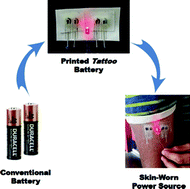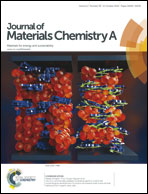An epidermal alkaline rechargeable Ag–Zn printable tattoo battery for wearable electronics†
Abstract
Herein we report for the first time the fabrication of a rechargeable, benign, skin-worn Ag–Zn tattoo battery using unconventional materials, such as screen printed electrodes, temporary tattoo paper, alkaline gel electrolytes and a PDMS cover for sealing the battery. The tattoo battery can be easily worn by a person for powering wearable devices. Detailed characterization of a typical Ag–Zn tattoo cell reveals a capacity density in the range 1.3–2.1 mA h cm−2 and stability up to 13 cycles. The tattoo cell exhibits a stable open circuit voltage of 1.5 V over a 5 days period and endures repeated stretching and bending strain cycles with minimal decrement in its performance. The lateral arrangement of the negative and positive electrodes allows the integration of several cells into a battery in series or parallel combination for tuning the discharge capacity and voltage to the desired values. The practical nature of the tattoo battery was illustrated by applying it to a human subject's skin followed by lighting a red LED. The epidermal tattoo battery thus meets the demands of wearable power sources, including mechanical compliance and tunable discharge capacity, to power body-worn electronic devices.


 Please wait while we load your content...
Please wait while we load your content...